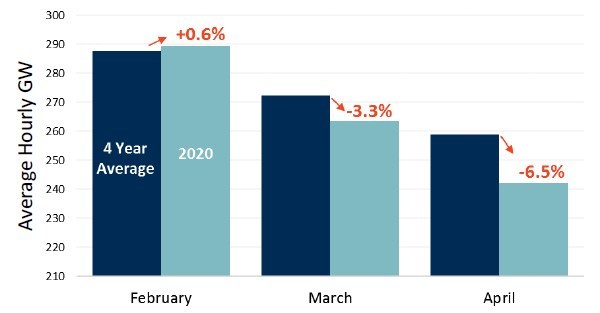
7 ISOs’ Electricity Load in February–April 2020 Relative to Load for Prior 4 Years (2016–2019)

Economists at The Brattle Group released on May 12 an assessment through April 2020 on the impacts and implications of COVID-19 on the energy industry. The report provides an update to an earlier compilation and assessment on the initial impacts through March 2020 of the pandemic on the industry.
The Brattle Group analyzes complex economic, finance, and regulatory questions for corporations, law firms, and governments around the world
The updated Brattle assessment shows that oil has experienced by far the greatest impacts on demand and price; in addition, demand has declined for electricity, and to a lesser extent for natural gas. Specifically, due to COVID-19 there was an average electric load reduction in April 2020 of -6.5%, about double the -3.3% effect seen in March 2020, as measured by the average impact on seven ISOs. Due in part to the essentiality of electric service, this drop may reflect the low ebb in average load reductions from social distancing, which is now starting to be relaxed (though further economic decline—and local conditions—could drive more load loss in some regions).
Other key findings of the Brattle assessment are as follows:
- Residential electric demand is up about 7%, while the demand from commercial and industrial (C&I) sectors is likely down about 15%. Because residential customers face mostly volumetric pricing while C&I customers have more fixed charges, it is likely that utility revenue losses will be smaller than load losses.
- Forward oil prices may not return to pre-COVID-19 levels seen last winter until 2026 or later.
- There are no clear COVID-19 effects on overall demand for natural gas. Residential usage was up this month compared to last year (with April being cooler than normal for most of the country), while industrial demand was down about 7%. Natural gas generation was down about 14% from March of this year, but up 4% compared to April 2019.
- Coal-fired generation appears to have the greatest lost production, due to reduced load and lower competing fuel costs, with some forecasters predicting it will decline 25% this year.
- There has not been a discernable reduction in renewable generation due to COVID-19, but there will likely be delays in renewable expansion currently signaled by renewable industry unemployment claims and reports of supply chain disruption. The adverse effects of such delays could be materially amplified by expiring tax incentives at year-end 2020. Industry consolidation may be one result of these conditions.
- In April 2020, 10 additional U.S. states set mandatory service termination moratoriums, bringing the total up to 32 states. The remaining 18 states have voluntary suspensions of utility shutoffs. Many states are reviewing expanded decoupling mechanisms for COVID-19-induced revenue losses.
- Most economists anticipate material improvements to the economy in the latter part of this year, possibly ending the year as a whole about 6–7% down in GDP. However, there are structural reasons to worry whether the recovery can be this fast, due in part to lagging testing and contact tracing infrastructure for the virus.
- There is more optimism in the stock market. Volatility has declined since its peak in March 2020 (but stays elevated at 2008–2009 levels), and the S&P 500 has rebounded to roughly September 2019 levels, with utility stocks also increasing but to a lesser extent in April 2020 than the overall market.
- Bond rates remain at historic lows. The investor-owned utility sector has been given a “negative outlook” by S&P, but only 3 utilities have had downgraded ratings. The public power sector has been deemed “stable” by Moody’s.
“Impacts and Implications of COVID-19 for the Energy Industry: Assessment through April 2020,” is authored by Brattle Principals Frank Graves and Robert Mudge, Associate Josh Figueroa, and Research Analysts Tess Counts, Lily Mwalenga, and Shivangi Pant.
